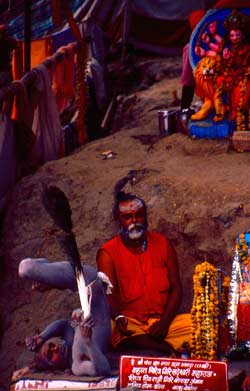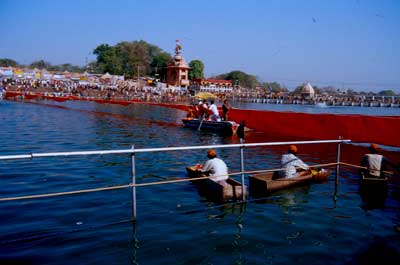|
Special Features
Behind the Scenes of Mahakumbha 2004, Ujjain |
|||||
My connection with the Simhastha Mahaparva or Ujjain Kumbha Mela ostensibly began in April '03, when I went there to pay my respects at the Mahakal Mandir, one of the 12 jyotir lingams. The Mahakaleshwar temple with its finely sculpted shikara, is located in a spacious courtyard near a lake. Legend has it that the demon Dushana tormented the residents of Avanti or Ujjain and that Shiva appeared from the ground and vanquished the demon. As a swambhu or self-born jytoirlingam, Mahakaleshwara Jyotirlinga, continues to be a permanent abode of Lord Shiva. The glory of Mahakaleshwar temple has been described in various Puranas and by many Sanskrit poets, including Kalidasa. It is here that the presiding deity of time, Lord Shiva reigns eternal, in all his splendour, giving darshan to devotees. |
More on Kumbha •Nashik Kumbha 2015 • Ujjain 2016 • Legends of Kumbha • Practical Guide • Sadhus at Kumbha • Photo Gallery 1 • Photo Gallery 2 • Photo Gallery 3 • Kumbh Haridwar 2010 • Kumbha Allahabad 2013 • Ujjain 2004 • Notes from the Kumbh • Friend to Sage • Vignettes Kumbha Cities • Ujjain • Haridwar • Allahabad • Nashik |
||||
 At the time I was also visiting Ujjain for a preliminary survey of the location of Simhastha 2004 and therefore called on the Commissioner and the Mela Adhikari for a first-hand idea of what the Simhastha planning involves. It was all theoretical at the time: maps and plans and polite conversations. A year later, the reality was very different. The elections, ensuing change of state government with differing policies and agenda, and the inevitable change of personnel in the bureaucracy had caused a major change in orientation and planning - everything was way behind schedule.
At the time I was also visiting Ujjain for a preliminary survey of the location of Simhastha 2004 and therefore called on the Commissioner and the Mela Adhikari for a first-hand idea of what the Simhastha planning involves. It was all theoretical at the time: maps and plans and polite conversations. A year later, the reality was very different. The elections, ensuing change of state government with differing policies and agenda, and the inevitable change of personnel in the bureaucracy had caused a major change in orientation and planning - everything was way behind schedule.
I was at Ujjain for a few brief hours in mid-February 04, when the allotment and possession of land was being given to the sadhu-sannyasins who had applied for it last year. I paid a brief visit to the Mahakal Mandir and to the Harsiddhi Mandir, one of the 51 shakti peeths. On 12th March, I reached Ujjain to integrate into the place and to be part of the Simhastha 2004. The preparations for the Simhastha were under way. I watched and participated in the activity behind the scenes: negotiated for tents, ran around for bulldozers to level the ground, made applications for water, electricity and sanitation facilities, shopped for provisions for setting up a camp. The administration was working well past midnight trying to get the delayed infra-structure in place. The akhadas were agitating at the lack of facilities, and indeed the conditions were abysmal. The sadhu-sannyasins were desperately setting up camps without the basic facilities of water and sanitation. An entire city was being built within 3-4 weeks, and at this nth hour, the administration was hurriedly building and widening roads.
The river Kshipra was almost pathetic in appearance - shallow, polluted waters. Diverted water was fed into it before Amavasya, or the new moon preceding the Navratri festivities, marking the official beginning of the Simhastha period on 21st March. The evening arati had changed character beside the river Kshipra- it had acquired a deep spiritual energy. People began to flock for a ritual bath, sadhus sat on the steps beside the river in quiet meditation. The waters of the river Kshipra were already energised. Every morning as I went into the Mela area I saw the massive security arrangements underway, with every kind of uniform well-represented, receiving instructions, on parade, on duty. The road rollers, the cleaning operations, the infra-structure related activities were now at frantic pitch. The heightened activity at the growing camps, the flocking pilgrims of rural India from different states, the growing spiritual congregation of sadhus and sants arriving, all contributed to the underlying excitement and expectancy. At the camps, the presence of the sadhus at their dhunis provided a contrast to the feverish activity - the preparation for the yagya sthals, the shamianas being erected for spiritual discourses, the kitchens for large-scale bhandaras or distribution of food at the larger camps of mahatmas and mahants, the ornate gates and other extras. Local journalists came scouting around the camps for interesting bits of news, which naturally centred around miracles, the magical and mysterious. The photographers in contrast desperately captured unusual images - sadhus playing cricket or glued to the television screen for India-Pakistan matches, hijacking a bulldozer and other trivia. Naga sadhus covered in ash and digamber sadhus without any clothing automatically attracted the attention of tourist, pilgrim and trigger-happy photographer, alike. Everyone I spoke to, connected to the Simhastha, be it senior government officials, village patwaris or security men deputed here on duty, conveyed a universally felt belief and faith that it was a blessing to be able to serve at the Simhastha. There was an incredible faith and humility and the deep-seated belief that they were working for a higher cause. This was reflected in the lack of arrogance and the politeness with which they dealt with everyone and all situations, albeit even if it did not always translate to efficiency. There was no denying the trying circumstances and the intent to serve. There were several occasions when I saw various government functionaries come into the camps, meet the senior sadhus, sit respectfully at their feet to take time off from their work to be energised by the spiritual energy of the saints. Everywhere, I saw the reverence and faith, the continuation of a tradition and culture so remote in history that it transcends all barriers. The Simhastha is a time-worn tradition that defies logic and definition. Like all those I met there, administrative functionaries, shopkeepers, auto-drivers and labourers, I am caught in the magical web of the Simhastha. I am happy to be there: involved, participating and remaining a witness. I intend to be there again from 31st March till the end of the Kumbha, when many of those present at the Kumbha will head towards the Himalayas to complete other missions. I too will turn towards the Himalayas for the summer, away from the crowds, the dust and the heat. |
|||||
Editor: Romola Butalia (c) India Travelogue. All rights reserved. |
|||||

 Every day till 24th March when I left for Mumbai, I watched a quiet sleepy town in Madhya Pradesh wake to action as it does every 12 years. A relatively empty Mahakal mandir grew increasingly crowded. From 1st March darshan at the griha garbha, or entry into the sanctum sanctorum will no longer be permitted. The transportation facilities at Ujjain are poor at the best of times, and it can be difficult to get auto-rickshaws - facilities were now stretched beyond reason. People will have to walk miles on melting tar and dirt tracks to different destinations. At intervals, basic sheds, toilets and drinking water facilities are being constructed. Later vehicles without passes will not be permitted in the main camping areas and adjoining bathing ghats. On bathing dates vehicular traffic is not permitted at all. It is advisable to ensure that travellers avoid entering or exiting Ujjain on these dates.
Every day till 24th March when I left for Mumbai, I watched a quiet sleepy town in Madhya Pradesh wake to action as it does every 12 years. A relatively empty Mahakal mandir grew increasingly crowded. From 1st March darshan at the griha garbha, or entry into the sanctum sanctorum will no longer be permitted. The transportation facilities at Ujjain are poor at the best of times, and it can be difficult to get auto-rickshaws - facilities were now stretched beyond reason. People will have to walk miles on melting tar and dirt tracks to different destinations. At intervals, basic sheds, toilets and drinking water facilities are being constructed. Later vehicles without passes will not be permitted in the main camping areas and adjoining bathing ghats. On bathing dates vehicular traffic is not permitted at all. It is advisable to ensure that travellers avoid entering or exiting Ujjain on these dates.